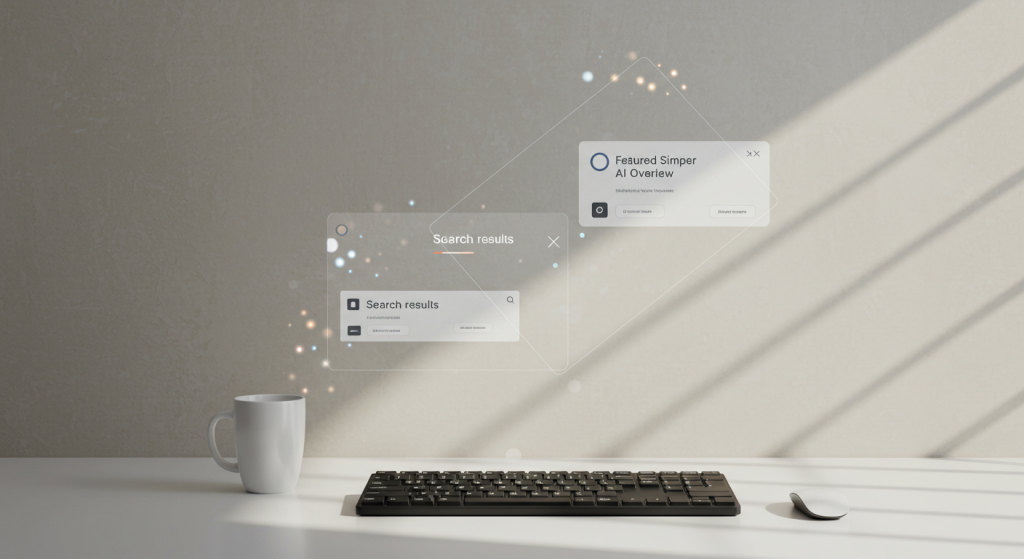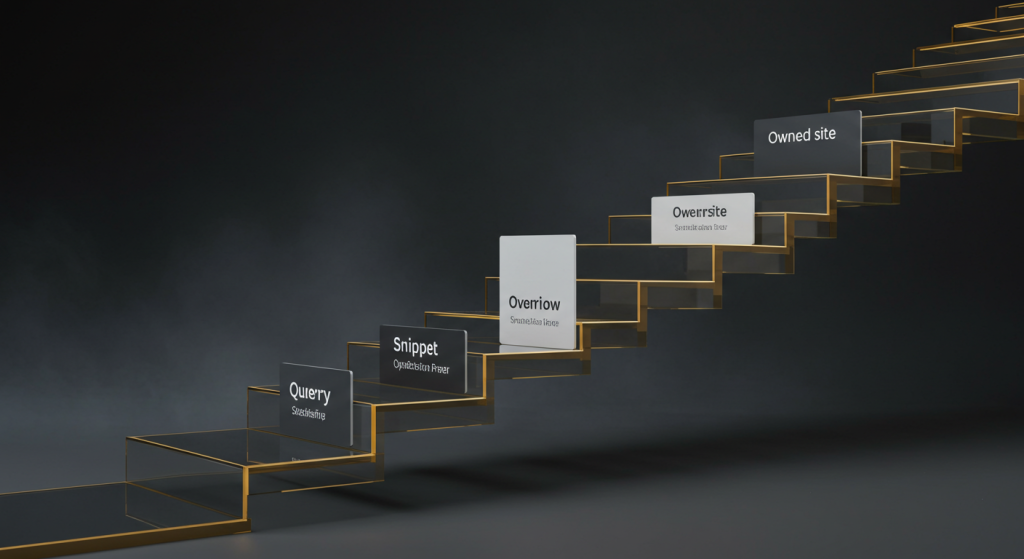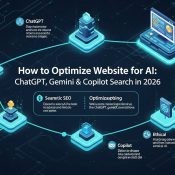
Zero-Click SEO in 2025: AI Overviews & Snippet Wins
Zero-Click SEO in 2025: AI Overviews & Snippet Wins
Short version: “Zero-click” is now the default for a big slice of searches. Featured snippets, “People also ask,” and especially AI Overviews (the rebrand of SGE) answer many queries on the SERP itself—and they’ve expanded worldwide in 2025. You can still win. This guide shows you how to engineer answer-first content that gets cited, selected, and clicked, while protecting your brand and conversions.

1) The 2025 reality check (and why this guide matters)
- AI Overviews went global in 2025 (200+ countries, 40+ languages), after a U.S. launch in 2024. That means way more searches now start—and often end—on Google’s page.
- Organic clicks are down, zero-click is up. Recent datasets show fewer organic clicks YoY and rising zero-click rates in both U.S. and EU/UK markets.
- Surveys and industry research also suggest users now rely on zero-click SERP answers for a significant share of their searches.
Translation: you don’t just need to “rank.” You need to be the answer source Google cites and the brand users still want to visit.
2) What Google says (and what it implies)
- Featured snippets: Google chooses them automatically when your page offers the clearest, most helpful answer. You can’t force them with markup—but you can format to help. Google for Developers+1
- Core updates & quality: Google’s 2024 updates doubled down on useful, original content and tightened spam policies. Thin, “made-for-search” content loses.
- Rich results changes: “How-To” rich results were deprecated, and the FAQ display was restricted, so don’t rely on them for visibility.
Implication: Answer-first structure + first-hand expertise + clear sourcing = more snippet/overview eligibility and fewer traffic surprises.
3) The KPI shift: measuring success in a zero-click world
Expect:
- Impressions up, CTR down on queries with AI Overviews/snippets.
- Branded searches up if your overview/snippet exposure lifts awareness.
- Assisted conversions rising in analytics, even when the last click isn’t organic.
Track (practical setup):
- GSC: Segment queries with/without snippets/“people also ask”/AI Overviews (use SERP features in your rank-tracker + map to GSC queries).
- GA4: Build an Assisted Organic exploration (Organic as touchpoint, not last-click).
- Heatmaps & scroll maps on your “answer hubs” to prove engagement from SERP visitors who do click.
4) The Answer-First Blueprint (A→D structure)
Use this to turn any topic into SERP-friendly, still-click-worthy content.
A. One-screen answer (for the SERP)
- Lead with a 40–60-word definition/summary that directly answers the core query.
- Follow with a 3–7 step list or bulleted takeaways (for list snippets).
- Include a crisp table when comparisons matter (for table snippets).
- Name your sources (primary studies, standards, docs) in the first 300–400 words—these often influence which pages get cited.
B. The click magnet (what users get only on your site)
- Provide visuals (original diagrams, calculators, embedded tools, before/after demos).
- Add decision frameworks, templates, or downloadable checklists (behind a soft CTA).
- Add fresh data (proprietary stats, case studies, field notes). AI Overviews like consensus—but unique evidence gives users a reason to click.
C. Experience & proof (E-E-A-T signals)
- Show who wrote it (bio with credentials), how you tested it, and trade-offs (pros/cons).
- Include dates (updated on…), version numbers, and change logs for evolving topics.
- Embed expert quotes (or your own experiments) that AI can cite.
D. Structured discoverability
- Tight H2/H3s phrased as questions (“How do I…?”, “What’s the difference…?”).
- Jump links/ToC (anchored headings) for “Jump to” sitelinks and better scannability.
- Schema: Article, FAQPage (even if FAQ rich results don’t always display), HowTo only if truly valid (remember: how-to rich result visual is deprecated).

5) Engineering featured snippets (and keeping the click)
Target snippet types:
- Paragraph snippet
- Open with a direct, one-paragraph answer (~40–60 words).
- Use the exact query language and synonyms in the paragraph and its H2.
- Immediately follow with a Why/How/Next sentence to spark curiosity.
- List snippet
- Convert steps or items into clean, ordered lists (5–8 bullets).
- Each bullet starts with the action noun/verb (no fluff).
- Beneath the list, expand each step with examples and visuals.
- Table snippet
- Use true HTML tables with succinct headers.
- Keep rows short, then link to a Full comparison anchored deeper on the page.
- Video snippet
- If you have video, add Clip/Seek markup so Google can jump to an exact moment. (This rarely forces a snippet, but it improves eligibility.)
Click insurance:
- Place “See the full framework” or “Use the calculator” directly under the snippet paragraph.
- Gate the asset light (email optional) and offer an instant preview so it’s worth leaving the SERP.
Remember: Google confirms featured snippets are algorithmically selected—no magic schema toggles. You help by being the best answer and formatting clearly. Google for Developers+1
6) Winning inside AI Overviews (AIO) without getting cannibalized
How AIO works at a high level: it synthesizes an answer and cites sources. In 2024–2025, Google expanded AIO from the U.S. to 200+ countries. If you want visibility, you want to be among those citations.
Practical playbook:
- Consensus-friendly atoms
- Include clear, quotable statements that agree with reliable references (docs, standards, reputable studies).
- For contested topics, separate “facts vs. opinions” and cite both sides. That clarity increases citation odds.
- Evidence & originality
- Add novel data (benchmarks, field tests, pricing studies, teardowns). AIO may quote consensus, but users click for the unique bits.
- Use source labels (e.g., “Methodology,” “Dataset,” “Limitations”).
- Safety, scope & recency
- Clearly state what your advice covers/doesn’t cover, and date your updates—AIO favors fresh, safer guidance for YMYL-adjacent topics.
- Multi-format support
- Pair text with diagrams, mini-infographics, and short explainer videos. Captions and alt text summarize the facts—extra surfaces AIO can reference.
- Sitelink-worthy structure
- Make each H2/H3 a self-contained mini-answer (with its own sources). These sections are more likely to be quoted or linked as jump targets.
- Brand recall hooks
- Add memorable frameworks (e.g., “Answer-First A→D”). When users see your brand name in the citations, they’ll search you later—even if they didn’t click the first time.
7) Topic selection for zero-click resistance
Pick angles where the SERP can’t fully satisfy curiosity:
- Local & temporal specificity: “2025 pricing for Lagos SMB backups,” “2025 Nigeria NDPR vs GDPR checklist.”
- Complex decisions: “Which WAF rules break my checkout?” “Entity SEO vs. programmatic SEO for a catalog of 5k SKUs.”
- Hands-on demos/tools: ROI calculators, CWV dashboards, pen-test scope templates, schema generators.
- Comparative nuance: Trade-offs, pitfalls, “when not to,” implementation costs—details AI summaries gloss over.

8) Format patterns that surface and convert
Pattern 1 — 60-Word Verdict → Depth
- Start with “TL;DR: [direct answer].”
- Then Decision Tree diagram (PNG/SVG), followed by 3 case studies (each with metrics + screenshots).
Pattern 2 — Question Cluster Hub
- One hub page targeting the head term.
- 8–20 spoke articles each answering a specific PAA question with tight 60-word answers up top and deeper walkthroughs below. Internal link both ways.
Pattern 3 — Comparison Matrix
- Table with must-know columns (use cases, limits, costs, integration).
- Add “What the matrix can’t show” section (context & caveats).
Pattern 4 — Field Notes
- “What broke when we enabled [X]” (post-mortems, changelogs, incident playbooks).
- These pieces earn links, brand trust, and non-commoditized clicks.
9) Schema & technical helpers (without “gaming”)
- Article / NewsArticle / BlogPosting with
author,datePublished,dateModified,headline,image,publisher. - FAQPage for genuine Q&As (display is restricted and not guaranteed, yet it’s still useful for structure). Google for Developers
- Speakable (if you publish audio companions) and VideoObject (with key moments).
- Sitelinks Searchbox (if relevant to brand navigational queries).
- Performance: Pass CWV on mobile, especially CLS for snippet eligibility and user experience.
- Accessibility & semantics: proper headings, lists, tables; descriptive alt text.
10) Link earning (what still works in a zero-click era)
- Original research (benchmarks, salary/pricing studies, teardown audits).
- Interactive tools (estimators, calculators, checkers).
- Public documentation (templates, SOPs, checklists developers actually use).
- Selective syndication with rel=canonical to avoid partner outranking.
- Expert roundups (but with real experiments and code samples, not fluff).
11) Legal & ecosystem currents to watch
- Publisher concerns & regulators: AI Overviews are facing scrutiny in some markets over traffic and content usage. Follow developments if you rely on ad-funded content.
- Robots vs. AI usage rights: New proposals from infra players aim to separate indexing from AI training/summarization permissions—watch for evolving controls if you publish proprietary research.
12) A practical 30/60/90 plan
Days 1–30: Foundation
- Audit your top 50 URLs that map to questions: add a 40–60-word direct answer + list/table where useful.
- Author pages: add credentials, methods, and update histories.
- Rebuild ToC + anchors for jump links; tidy H2/H3 question phrasing.
- Add source boxes (cited standards/docs).
- Spin up one interactive asset (calculator, checklist, template) for your highest-value page.
Days 31–60: Expansion
- Cluster build-out: 10–20 spoke articles answering PAA questions; link to hub and between spokes.
- Two original studies or deep teardowns; pitch to newsletters/communities.
- Add video explainers (60–120 s) to 5 core pages with Clip/Seek key moments.
Days 61–90: Moat & measurement
- Benchmark report (annual/quarterly) that others will cite.
- GA4 assisted conversion dashboard; compare pre/post snippet changes.
- Iterate: improve CTR with “What we cover next” teasers and placing premium assets above the fold.

13) Example: Turning a snippet win into a click win
Query: “Programmatic SEO for service businesses”
On-SERP snippet: Your 55-word rundown + 7-step list appears.
Above-the-fold on your page:
- “Launch kit” (free template bundle)
- Interactive cost estimator (exportable)
- 2 mini case studies with real numbers
Result: You retain the answer spot and give concrete reasons to click.
14) Mistakes to avoid
- Answer hoarding (burying the answer). In 2025, hiding the lead just cedes the snippet to someone else.
- Over-templating content (thin variations). Core updates punish this.
- FAQ farming, hoping for rich results (display is restricted; write FAQs for humans). Google for Developers
- Syndicating without a canonical and getting outranked by partners.
- Ignoring brand—zero-click boosts awareness; if your name isn’t memorable, you lose the halo.
15) Executive checklist (print this)
- Each target page opens with a 60-word direct answer.
- One list/table near the top if format fits.
- Anchored ToC and question-style H2/H3s.
- Citations/sources in the first 300–400 words.
- Unique asset (tool, template, chart, case data) above the fold.
- Author bio + last updated + methodology.
- Article/FAQ schema; video key moments if present.
- GA4 assisted conversion view and GSC feature monitoring.
- Cluster: hub + 10–20 spokes, interlinked.
- Quarterly study or benchmark to earn links.
5 FAQ (copy + schema-ready):
- What is zero-click SEO in 2025?
Zero-click SEO means optimizing so your brand is the cited answer on the SERP (featured snippets, AI Overviews, PAA), while structuring pages with unique assets that entice users to still click for depth. - Can a schema force a featured snippet?
No. Schema helps machines understand your page, but featured snippets are algorithmically chosen for usefulness and clarity. Clear formatting boosts eligibility. - How do I get cited in AI Overviews?
Publish answer-first copy that matches expert consensus, cite reliable sources, add fresh evidence (studies, tools), and keep content updated and safe. - Are FAQ and How-To rich results still a thing?
How-To rich results were deprecated, and FAQ display is restricted; create FAQs for users, not for guaranteed rich results. - What should I track in GA4/GSC?
Monitor impressions vs. CTR on snippet/AIO queries, assisted conversions, and branded search growth. Use rank-trackers to flag SERP features and correlate with GSC.




